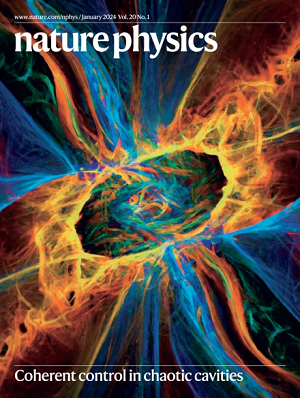Highly anisotropic superconducting gap near the nematic quantum critical point of FeSe1−xSx
IF 17.6
1区 物理与天体物理
Q1 PHYSICS, MULTIDISCIPLINARY
引用次数: 0
Abstract
Nematic phases, in which electrons in a solid spontaneously break rotational symmetry while preserving translational symmetry, exist in several families of unconventional superconductors. Superconductivity mediated by nematic fluctuations is well established theoretically, but it has yet to be unambiguously identified experimentally. One major challenge is that nematicity is often intertwined with other degrees of freedom, such as magnetism and charge order. The FeSe1−xSx family of superconductors provides an opportunity to explore this concept, as it features an isolated nematic phase that can be suppressed by sulfur substitution at a quantum critical point where the nematic fluctuations are the largest. Here we determine the momentum structure of the superconducting gap near the centre of the Brillouin zone in FeSe0.81S0.19—close to the quantum critical point—and find that it is anisotropic and nearly nodal. The gap minima occur in a direction that is rotated 45° with respect to the Fe–Fe direction, unlike the usual isotropic gaps due to spin-mediated pairing in other tetragonal Fe-based superconductors. Instead, we find that the gap structure agrees with theoretical predictions for superconductivity mediated by nematic fluctuations, indicating a change in the pairing mechanism across the phase diagram of FeSe1−xSx. Superconductivity that is mediated by fluctuations of a nematic electronic order has not been experimentally demonstrated. Now an analysis of the symmetry of the superconducting gap in doped FeSe provides evidence of this phenomenon.


FeSe1-xSx 向列量子临界点附近的高各向异性超导间隙
向列相是指固体中的电子在保持平移对称性的同时自发地打破旋转对称性,存在于多个非常规超导体系列中。由向列波动介导的超导电性在理论上已经得到了很好的证实,但在实验中仍有待明确确定。一个主要挑战是向列性往往与其他自由度(如磁性和电荷秩序)交织在一起。FeSe1-xSx 系列超导体为探索这一概念提供了一个机会,因为它具有孤立的向列相,可以通过在向列波动最大的量子临界点进行硫替代来抑制向列相。在这里,我们确定了 FeSe0.81S0.19 中布里渊区中心附近--接近量子临界点--超导间隙的动量结构,并发现它是各向异性的,几乎是结点结构。间隙最小值出现在一个相对于铁-铁方向旋转 45° 的方向上,这与其他四方铁基超导体中由于自旋介导配对而产生的通常各向同性间隙不同。相反,我们发现间隙结构与理论预测的由向列波动介导的超导性一致,这表明 FeSe1-xSx 相图中的配对机制发生了变化。
本文章由计算机程序翻译,如有差异,请以英文原文为准。
求助全文
约1分钟内获得全文
求助全文
来源期刊

Nature Physics
物理-物理:综合
CiteScore
30.40
自引率
2.00%
发文量
349
审稿时长
4-8 weeks
期刊介绍:
Nature Physics is dedicated to publishing top-tier original research in physics with a fair and rigorous review process. It provides high visibility and access to a broad readership, maintaining high standards in copy editing and production, ensuring rapid publication, and maintaining independence from academic societies and other vested interests.
The journal presents two main research paper formats: Letters and Articles. Alongside primary research, Nature Physics serves as a central source for valuable information within the physics community through Review Articles, News & Views, Research Highlights covering crucial developments across the physics literature, Commentaries, Book Reviews, and Correspondence.
 求助内容:
求助内容: 应助结果提醒方式:
应助结果提醒方式:


